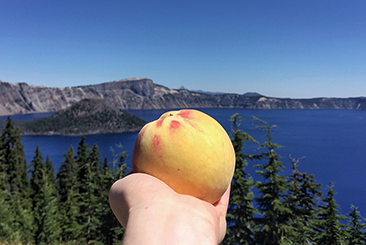How to Make Fresh Pasta

Homemade pasta dough is incredibly forgiving and has only 4 basic ingredients. That being said, up until a couple of years ago I always figured pasta would be too complicated for my amateur skills. Turns out that's just crazy talk...sort of. It takes a couple of times to get a feel for the dough and process, but generally speaking homemade pasta is easy to make and the end result is 100% worth the effort.
More importantly, when you sit down to eat said pasta, try not to sprain your shoulder while patting yourself on the back. Step-by-step instructions below.
Recipe
Once you get a feel for your dough, the recipe is almost secondary. Many of the videos I watched use very loose measurements (handfuls of flour rather than cups) and the chef simply mixes the flour and eggs by hand until he/she reaches the right consistency. That being said, I measured everything for this recipe right down to the dough ball and have included those notes. I like having a repeatable process that gets me to the same consistency without too much fussing.
The rule of thumb for basic dough is 95-100g (or roughly 1cup) of flour to 1 large-xlarge egg. Humidity, air temperature, and egg size will all impact how much or little flour you ultimately need.
Flours
My recipe uses both "tipo 00" and semolina flour. This post is already way too long so I'll be brief in explaining my ratios.
In Italy, tipo 00 is the finest milling grade for flour. When I made pasta with 100% tipo 00 is was incredibly tender, but for fettuccine and lasagne it was too tender. Semolina has been added for texture.
Tools
There are several pastas that can be made without a machine (pici and gnocchi being examples), but for lasagna, pappardelle, linguine, etc. a pasta attachment is helpful. This is especially true if you have limited counter space. If you want to try making everything by hand I've included links for that below.
This is the machine I started with and it's a perfectly nice piece of equipment. Unfortunately I didn't use it as often as I would have liked since the hand-cranking wasn't conducive to producing more than one dinner's worth of pasta. I also found the low height to be tricky when it came to long sheets of pasta. The workaround for the latter issue is to create a never-ending pasta loop by pinching the two ends together, hence continuously feeding the pasta through the machine. Ultimately my Imperia ended up on Ebay and I graduated to the Kitchen-Aid Pasta Attachments.
KitchenAid Pasta Attachments (also here and here)
Awww yeah. If you like to make pasta, I cannot recommend this investment enough. I roll my dough on speed 3 (speed 2 when the pasta is delicate) which makes the whole process fly by. The height of the mixer gives me more room for the longer sheets and having both hands free to manage the dough is super helpful. However, I don't recommend brushing away flour while the fettuccine roller is running as the machine will eat the brush. Captain Obvious has been there. Just wish I had photographed that bit of genius.
Also...
- OXO Scale - You have a scale at this point, yes?
- KitchenAid Professional Mixer or KitchenAid Artisan - I recommend cutting back on the quantity for the Artisan since the motor might get a little tired.

Eggs at Jaime Farms - Santa Monica Farmers Market
Ingredients
- 300g tipo 00 flour (roughly 3 cups) Note: Italian delis that have a shopping section often carry this flour or you can order it online. All-purpose can be substituted if you can't find tipo 00.
- 200g semolina flour (roughly 2 cups) Note: All-purpose can be substituted here as well if necessary.
- 2 tsp olive oil
- 5 large-xlrg eggs Note: Size matters. I used medium-large eggs for my last batch of dough and ended up having to throw in an extra yolk and some olive oil because the texture was too dry. For reference, in the shell those eggs were 57 grams (about 2 oz) each.

Instructions // by hand
I don't have the counter space for rolling by hand, but if you want to give that a try here's a helpful video on making the dough. Here is a (shaky but still clear) video for rolling the pasta, another one here.
Instructions // with a mixer
Mixer
- Set your mixer bowl on the scale and measure your flour
- Make a well in the center, then add your eggs and oil
- Whisk the eggs with a fork
- Continue whisking in the center of the bowl, slowly pulling in bits of flour from around the edge Note: This video is a great example of the mixing technique. The only difference is he's whisking on a counter and I do it right in the bowl.
- Keep going until enough flour has been added and it's tough to keep whisking with the fork
- With your hands, slowly pull the rest of the flour in from the sides and mush it around Note: If you feel like the dough is beginning to get stiff or dry (this is why hands are always best tool), dump the remaining loose flour into a separate bowl and set aside.
- Using the dough hook attachment, mix for about 7 minutes on medium-low (setting 2)
Troubleshooting Notes: Sometimes the dough is too dry or too wet which causes it to cling for dear life to the hook and/or side of the bowl. Below are some tips that have worked for me. After making pasta dough a couple of times you'll get a feel for what works best in your kitchen.
- If the dough won't release from the side of the bowl after about 3 minutes of machine mixing, sprinkle a smidge of tipo 00 flour around the edge to free it up. Be sparing with the flour and patient with the dough since it should eventually come together. If you're still waiting after another minute then it probably needs a bit more flour.
- If the dough won't release from the hook after a few minutes it may be too wet or too dry (I've had both happen). Stop the mixer, pull the dough off off the hook, and reorient it. Do this a couple of times if necessary. If that doesn't work, add a sprinkling of flour for wet dough or 1tsp of water for dry dough. Pasta dough doesn't require the precision of baking and I've found no ill effects adding these ingredients later in the game. Just be sure to thoroughly incorporate them.
Kneading and Resting
Many recipes and videos suggest sprinkling your work bench with flour as a universal step. Mmm, no. If you're using a mixer to knead then you probably already adjusted the moisture and have a great texture. Similar to what I've read about the bread-making process, flour should only be added at this point if it's necessary.
- Turn the dough out onto a work surface
- If the dough is still sticky, put a few drops of oil on your hands
- Knead for about 3 - 5 minutes until you have a smooth dough ball Note: If after a minute or two the dough is still sticking to your hands or the work bench, sparingly sprinkle with flour and be sure to incorporate thoroughly. Add additional flour as needed.
- Cover tightly in plastic and rest for at least 30-45 minutes at room temperature
Rolling the Dough
I ran into trouble with the logistics of rolling/cutting/storing when I started making pasta dough. For my own benefit (and hopefully yours) I documented the process. It's not the "correct" way, just the approach that works for me.
- Line a baking sheet with parchment paper and sprinkle with semolina.
- Cut the dough ball into five equal pieces.
- Wrap four of the pieces tightly in plastic wrap so they don't dry out.
- Flatten the remaining piece of dough until it's about 1/2 inch high and 2 inches wide.
- Run the dough through the pasta attachment on setting 1 (the widest) Note: If your dough is the right consistency you shouldn't need any flour. That being said, if it's sticky and not running smoothly you'll need to dust it with tipo 00 or all-purpose - whatever you're using.
- Fold the dough into thirds by pulling each end inward, then feed it through again with the open seam down.
- Repeat above step.
- Fold the dough in half lengthwise, then feed it through with the open seem to the side. Note: I do this to keep the pasta sheet from getting too wide.
- Run the dough through again without folding.
- Move to setting 2 and run the dough through two times, then repeat with settings 3 and 4, running the dough through two times each. Note: Throughout this process your dough will feel warm and almost-but-not-quite moist. That's perfect. If the dough is sticky or you start to notice rippling then dust lightly with flour.
- Move to setting 5 and run the dough through three or four times. Note: The pasta sheet is done when it's slightly transparent and so silky that you want to rub it on your face. Thickness is a matter of taste so you may want to continue on to width 6 or stop at 4.
- Install your pasta cutter (if using) and cut the pasta, or cut by hand like this.
- Drop your noodles on the parchment, sprinkle with tipo 00 flour, and gently toss.
- Check on the pasta after a few minutes and make sure it isn't stiking together.
Serving
I heat my Roasted Tomato and Red Pepper Marinara Sauce in a pan large enough to fit both the sauce and noodles.
Add the fresh pasta (or pasta immediately out of the freezer) to a large pot of salted boiling water. Did I mention the water should be salted? Cook for a minute or just before al dente (thicker noodles will need more time), then transfer directly to the sauce and finish cooking. Reserve some pasta water to use if the sauce is too thick. Note: Finishing your fresh pasta in the sauce creates a more cohesive dish since the noodles are able to absorb some of the flavors.
Add desired fresh herbs, grate some fresh Parmigiano-Regiano over the top, and enjoy!
Storing
Rob and I can eat a combined 7-8 oz of pasta so I nest the fresh noodles in 2 - 2 1/2 bundles, flour generously, and freeze fresh (not dried) in a sealed plastic bag. The texture is not exactly the same as day-of noodles but it's definitely better than the boxed stuff.
Some sites suggest drying the pasta, though I've also read this makes egg noodles brittle.







